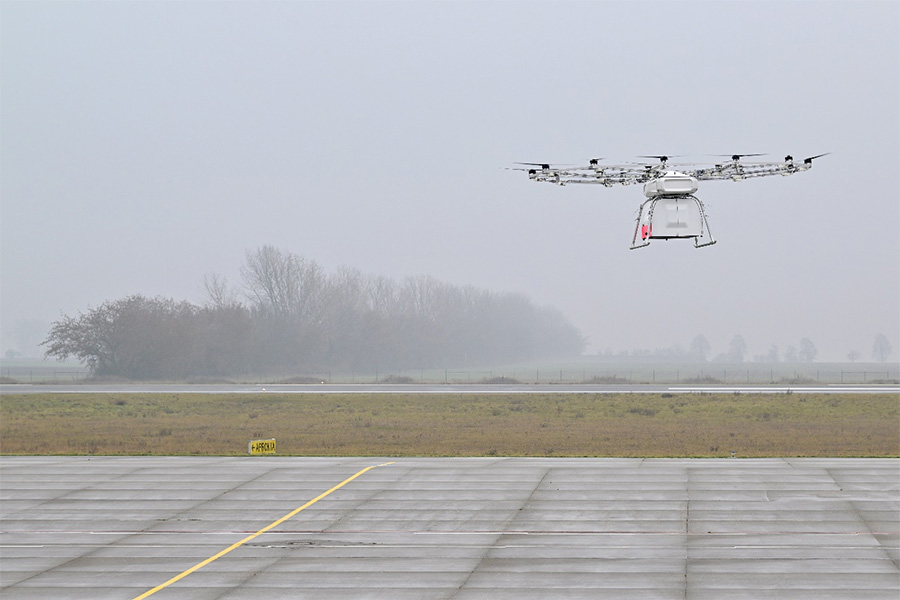Partners in the SESAR CORUS-XUAM very large-scale demonstration ran their final flight tests using a cargo drone from Volocopter and testing deconfliction between crewed and uncrewed aircraft. Taking place in Germany at DLR's National Experimental Test Centre for Unmanned Aircraft Systems at Magdeburg-Cochstedt Airport, the tests simulated two research scenarios for urban areas in London and Frankfurt/Main for the first time. The multi-national research team composed of DFS Deutsche Flugsicherung GmbH, DLR, Droniq, NATS, and Volocopter presented their flight tests to the invited guests at an open day on 30 November 2022.
Drones and drone technology will change our everyday lives. They may soon be more visible in the skies, ranging from delivery drones to air taxis. But in order for drone flights to become a part of everyday life in the coming decades, clearly defined regulations, flight corridors, and safe air traffic management (ATM) for new airspace users are needed. After all, conventional air traffic and future uncrewed aircraft must operate smoothly and reliably side by side in a safe manner. Flight tests are essential for designing and testing realistic unmanned aircraft system traffic management (UTM) for uncrewed air transport. To this end, a series of large-scale demonstrations (VLDs) have taken place throughout the year within the framework of the EU project CORUS-XUAM.
The VoloDrone is being developed by Volocopter to deliver up to 200 kilograms of cargo in an all electric flight at a distance of up to 40 kilometres. The flight tests in Cochstedt simulated with this drone an air taxi scenario for the connection between the city centre and the major airports within the metropolitan regions of London and Frankfurt/Main. It focused on the digital communication interface for ATM/UTM, including contingency management in the event of unforeseen conflict scenarios, and potential routing and air traffic management solutions. In the scenarios, the flight request, flight planning and flight execution from takeoff to landing were remotely piloted/automated. Up until now, air traffic management in conventional air traffic has been largely based on VHF radio communication between pilots and air traffic controllers. In the future, the operation of a large number of uncrewed aircraft will require a digital and highly-automated system that complements traditional air traffic control systems.
To achieve this, the U-space concept is currently being developed throughout Europe. In the future, drone flights are to operate in U-space airspace – from takeoff, flight, and landing. The flight test demonstration at the Cochstedt drone test site showed how the VoloDrone flies scaled-down versions of the flight routes under research. For the Frankfurt scenario, this was the simulated route between Frankfurt Messe and Frankfurt Airport. For the London scenario, this was a potential route between London City Airport and London Heathrow Airport. Suitable locations for vertiports, takeoff and landing sites for future air taxis were determined for both scenarios. The flight tests focused particularly on the testing of deconfliction manoeuvres and procedures. Exemplary here are prioritized Emergency Medical Services (EMS) aircraft that are given priority: this was clearly demonstrated in the flight tests with an ADAC EMS helicopter in the 'Frankfurt scenario', where the VoloDrone automatically adjusted its flight path to avoid the EMS helicopter. In the 'London scenario', the research teams tested how reducing the speed of the VoloDrone could be used to maintain separation with commercial air traffic, or to give more time to carry out ground operations at the destination vertiport in preparation for arrival.
Overall, the flight tests in Cochstedt are part of a whole series of demonstration tests within the framework of the EU project CORUS-XUAM. Prior to this, large-scale demonstrations took place in Spain, Italy, France, Sweden and Belgium to gain experience with the integration of uncrewed aerial NATS Internal vehicles alongside existing air traffic in various urban areas. The results will be incorporated into the further development of the European U-space Operations Concept (CONOPS). Well-established standards and regulations for uncrewed air traffic are urgently needed so that the industry can unfold its great predicted development potential. The research work in the CORUS-XUAM project is funded in the EU research programme SESAR under the number 101017682.

This project has received funding from the SESAR Joint Undertaking under the European Union’s Horizon 2020 research and innovation programme under grant agreement No 101017682.
